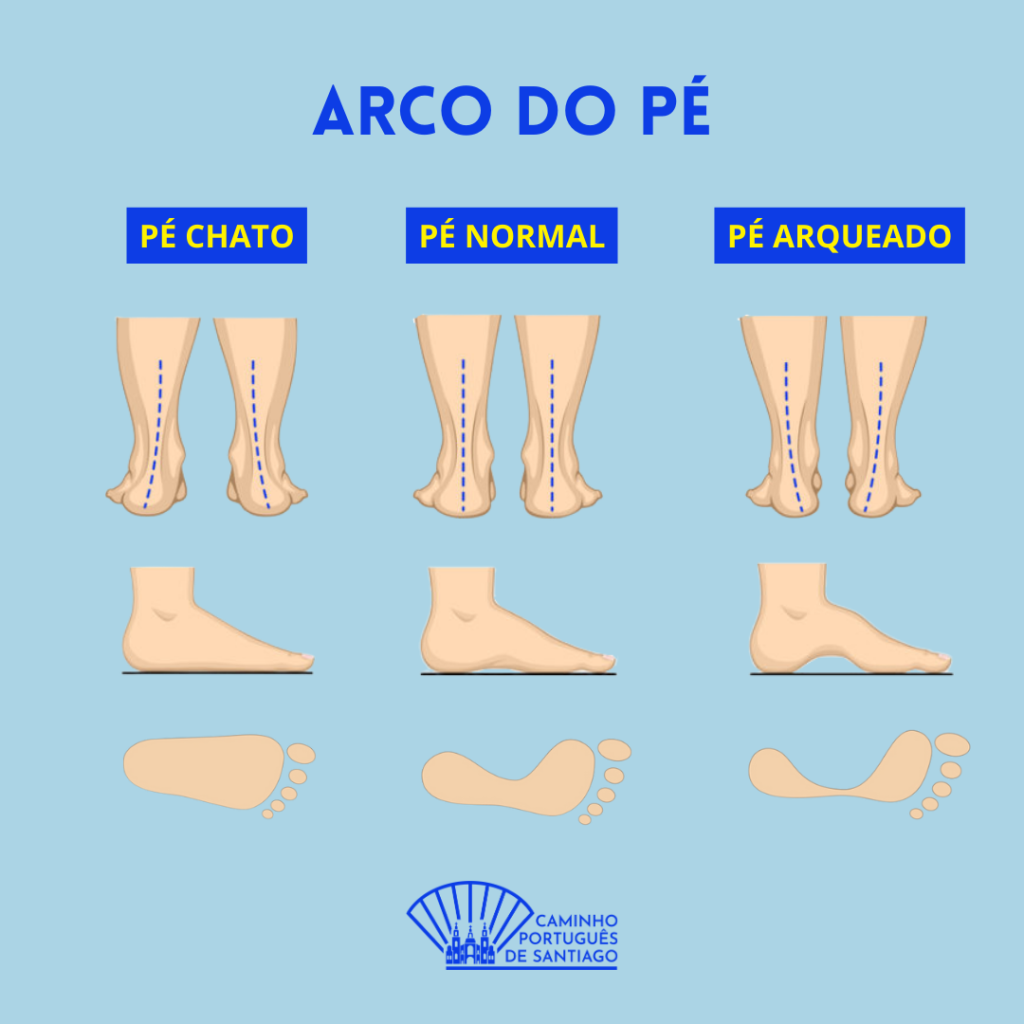What you wear is the most important choice if you want to walk the Camino de Santiago safely, avoiding injuries and unnecessary difficulties along the way. That's why we've written this article to help you make the decision that best suits you. Read to the end to find out more about the options available, the best practices when buying and some suggestions!
Why should you choose the right footwear for the Camino de Santiago?
The answer to the question of what shoes to wear on the Camino de Santiago is simple! After all, footwear has several functions. Quality boots or sneakers protect you from external hazards such as sun and rain, as well as internal ones. For example, the moisture created in the feet when you exert yourself physically. What's more, whatever product you use to protect this bone structure must adapt to your stride.
Yes, because everyone walks differently. Read on to find out more about foot movement and how it should influence your choice!
How does the floor work?
The act of walking follows a similar rhythm in all people. It is usually divided into six different movements, but this is not always the case. Some people, due to their foot type, can develop more complex ways of walking. The types of feet that exist are:
- Foot with flat arch;
- Foot with normal arch;
- Foot with high arch;
In this way, everyone changes the way this limb, which is responsible for mobility, hits the ground. So you need to find out which way your foot leans in order to distribute your weight when it hits the ground. These are:
- Supination: Normal on feet with a high arch.
The outside of the heel hits the ground at a greater angle, with little or no inward lean, resulting in a huge shock transition through the foreleg.
- Neutral: Normal on feet with a normal arch.
The foot rests on the outside of the heel, then leans inwards to absorb the shock and support the weight of the shock.
- Pronation: Normal in feet with a flat arch.
The foot rests on the outside of the heel, then leans too far inwards, transferring the weight outwards rather than onto the sole of the foot. This can lead to injuries such as shin splints, plantar fasciitis and even bunions.
How can you tell if you have a pronator or supinator gait?
There are two ways to do this:
- Look at the wear on your soles.
If you look at what you're wearing now, chances are you'll find the answer you're looking for. Especially if they're old shoes. That said, try to identify where they are most worn.
If the outside has more wear marks, then you have a supinator gait, like 10% of the population. On the other hand, if it's the inside that's more noticeable, then you have a pronator stride. You're not alone here either, as you share this trait with 45% of people. If you don't notice any significant difference, you have what's called a neutral gait, which is the healthiest, as it distributes the weight across the whole foot.
- Look at your footprints.
This method, although less practical than the previous one, is just as effective. To do it, you need 3 elements: Your feet, water and a sheet of paper.
It may sound cartoonish, but all you have to do is wet one of your feet and see what kind of mark it leaves on the paper. This will trace your gait, identifying the areas where you put the most pressure.
Follow these images to help you identify the three types of stride and which is yours:
The various types of foot and how they can lead to a form of stride.
Which shoes to choose in each case?
Whether it's sneakers, boots or sports shoes, the market has adapted to these different situations, creating solutions for each one. Look for these features when choosing your footwear for the Camino de Santiago.
- Cushioning: suitable for the supinator step
- Stability control: suitable for neutral pitch.
- Movement control: suitable for the pronator step.
Now that we've seen how your stride should influence your choice of footwear, let's start thinking about the Camino.
In addition to the factors that come naturally to you, such as the way you walk, you should also take into account the route you're going to take. These 3 questions will help you understand which shoes are best for you.
The type of road you'll encounter during your journey is essential to understanding what type of footwear you'll need to accompany you on this adventure. In the case of the route to the capital of Galicia, each one has different characteristics. Therefore, all the soils are different: in mountainous terrain, it may be better to take heavy boots to give you stability. Or, if you know that the route is mostly on dirt, you might prefer something lighter. So the first step is to know your pilgrimage style.
- How are you going to do the Camino?
In other words, in how many days you plan to do it; will you take it or not? backpack with you during the hike, or are you going to hire a transportation service? If you're still in doubt, then hiking shoes might be just what you need, as they tend to be more adjustable to different experiences.
- When are you going on the pilgrimage?
Anyone who has walked the Camino de Santiago knows that San Pedro likes to mix up the weather in Galicia. The locals even have a proverb to warn newcomers: "It always rains in Galicia," you might hear on your journey. Therefore, choosing water-resistant footwear can be a good option, especially if you're going in winter.
What other important features should you look for in footwear for the Camino de Santiago?
As we've seen above, there are many factors that play a part in choosing footwear for the Camino de Santiago. However, although it's a complex decision, more information can help you get an idea of what suits you best. So take these points into account:
- Support.
On long hikes, the terrain is mysterious. So you need all the help you can get to stay stable during your stride. This is because the ground can play tricks on you, increasing the risk of injury. A solid shoe is the support you need at such times.
For this reason, the sole must be resistant to ensure your safety. Likewise, the rubber must provide protection against external elements, such as the earth. At the same time, it can't be heavy, keeping your stride stable.
- Breathability;
When you exert yourself physically, your body gives off heat. The same happens when we walk. For this reason, footwear must allow the necessary ventilation so that your feet don't get too hot and concentrate moisture.
This is the main culprit behind the terrible blisters that pilgrims often experience. Therefore, the fabric must be able to absorb it while maintaining a healthy temperature.
- Weight;
On the millennial trail, every kilogram counts. So the weight of the shoes is an important factor when choosing. The heavier the pair of shoes, the more difficult the adventure will be.
However, there is always the downside of the medal, as it is those that weigh the most that offer the greatest protection against the external environment. For example, running shoes are lighter throughout the journey, but less secure.
So the important thing is to find a balance that you feel comfortable with. This is also why you should prepare yourself before crossing to Santiago de Compostela, especially if you're not used to walking.
- Cushioning;
The pressure that a single step makes is enough to influence the entire functioning of the body, impacting on joints as sensitive as the knees. That's why the better your shoes are prepared to absorb this "shock", the less likely you are to suffer from injuries or pain at the end of the day.
- Comfort;
Later on, you'll find a short list to help you choose the most comfortable footwear!
In addition to safety, the footwear needs to be comfortably adapted to your foot, so that you can enjoy the incredible journey that is the trail to the capital of Galicia. This involves the thermal sensation, the ease of moving the bone structure and the space available so that the skin doesn't rub against the fabric. After all, this last point is the main cause of blisters.
- Durability;
Footwear for the Camino de Santiago is an investment and, as such, should last a long time. It's important because the route is long and you should have the security of knowing that you won't run out of much-needed protection halfway along the trail.
- Protection;
Finally, the main purpose of footwear is to protect you from the conditions of the trail. It's no different on the millenary route, since you have a lot of different soils, as we talked about earlier, with unique characteristics between them.
What kind of shoes are available?
With so many suggestions, you're probably wondering: What are my options? Don't worry, here are some suggestions, with the negative and positive points of each, so you can choose!
These shoes are the first thing you think of when you start hiking. However, despite being a solid choice and used by many pilgrims, it also has its downsides, as they can be too heavy for beginners.
However, they're great for cold seasons when it's raining. What's more, they give you more stability to tackle the trail head on, whether it's wet, dry or just a change of scenery.
Positive points:
- The heels have more support on rough terrain and when carrying backpacks.
- They provide greater stability.
- They last longer.
- Most are water-resistant.
Negative points:
- Heavier than the other options.
- Less flexible than sneakers, so they require a longer adaptation period.
- They don't allow the foot to breathe.
Our suggestions:
So much for so little. With good grip, it adapts to the shape of your foot, promoting a comfortable stride throughout the journey. What's more, the rain in Galicia will no longer be a problem. This product's good waterproofing will help you keep your feet dry, even if you take your Camino to the high mountains of Serra da Estrela in the months when it snows.
If you need a good boot at a good price, here's the MH500. Warm for when you're on pilgrimage in the winter months, and comfortable for when the journey is long, those who wear them know that they'll arrive at their destination with their feet in good condition.
Boots designed to be worn (a lot). They cushion every step, on any terrain, so you can walk the Camino de Santiago in rain or shine. What's more, they're so comfortable that you'll feel at ease straight away.
Good for going out for bread or even to the capital of Galicia. When compared to running shoes, they are much heavier, but never to the point of being compared to boots. Stable, they tend to be more durable than other options and are flexible in their use. Excellent for those who know they're not running a race and want to enjoy every moment of the journey in safety.
Positive points
- They protect your feet more than sneakers;
- They are flexible and need less time to adapt;
- Some stability on the ground.
Negative points
- No heel support.
- Less durable than boots.
Our suggestions:
The perfect option for those who like lightweight footwear. In summer, they keep your feet cool, preventing excess moisture and, consequently, blisters. What's more, they're pretty!
Its modern yet discreet design is just one of the qualities of this mountain shoe. Whether you're on cold, rainy terrain or in the scorching heat of the Iberian summer, this shoe has your back. It also adapts to your foot comfortably, so you can go further.
Comfort, grip and resistance. These are the words Merrel uses to design its hiking shoes. Because anyone who knows the world of trails knows that these crossing partners need to be light to help you get further, but strong enough to withstand your step.
Sports or trail running shoes.
More and more people are choosing sports shoes, and for good reason. Lightweight and increasingly resistant, they are a good option for those who want to make the journey without weights.
Positive points:
- Lightweight and with virtually no adaptation time required;
- They allow the foot to breathe.
Negative points:
- No heel support;
- Less durable than boots;
- Most are not water resistant.
Our suggestions:
Made from sturdy materials, they're ready for you to walk the entire Portuguese Camino de Santiago from Lisbon and back, without weighing your feet down. What's more, they're so flexible that even the widest feet can move without difficulty.
With this running shoe, your steps won't leave you on the ground. Its hard sole gives you the stability you need to run up the Serra da Labruja and down to Redondela without any accidents. It's worth investing in good brands.
Don't let their tough look fool you. These running shoes are little clouds for your feet. Experienced pilgrims recommend them to anyone who enjoys long walks.
It may seem like it, but you haven't gone back to the beginnings of the Santiago route. Sandals are a good option for people who easily get blisters on their feet. This is because they allow warm air to escape without it getting trapped in the fabric.
Positive points:
- Less chance of blisters;
- Lightweight.
Negative points:
- Buckles can hurt;
- The feet are more exposed to the elements;
- Less resistant. If the buckle rips, you won't have any shoes.
Our suggestions:
Comfortable, light and fresh: these sandals have everything you need to walk the Camino de Santiago comfortably. Stand up to blisters with shoes that look elegant and adapt to your feet.
Made from a robust and durable material, they can withstand any Camino de Santiago you want to take. At the same time, they provide walking stability and cushion the shocks of footsteps.
You can take them to the beach, to work or to the capital of Galicia. As well as being comfortable, they're also versatile. Their modern look comes with the right technology to stabilize your steps on the millennial trail.
5 tips for choosing the right shoes for you!
Now that you know all about the various types of footwear suitable for the Camino de Santiago, we'll leave you with a few more suggestions for when you make your purchase. Whether it's boots or sports shoes, the important thing is that you feel comfortable. Don't forget that you have many kilometers ahead of you!
- First, you need to know what size you're wearing. Depending on the brand, this can change, so always try them on first. In addition, you shouldn't just think about the length of your foot, but also its height. That way, you'll get comfortable shoes that suit you.
- At the end of the day, your feet swell. So when you try it, try to do it at sunset.
- Try to see if your foot fits comfortably in the shoe. Use the familiar technique of placing your thumb on the toecap. It shouldn't be too close or too far.
- Take a walk around the store to see if you like the feel. Think about comfort and weight to help you.
- Start practicing with your new acquisition, well before you take the millennial route!
What do you need to start the Portuguese Camino de Santiago?
Now that you know how to choose footwear for the Camino de Santiago, all you need to do is start planning your adventure. Use our website to get all the information you need and to set off on the Portuguese Camino de Santiago.
If you need company, know that you're never alone on the trail. In fact, not before, since we have an incredible community of more than 70,000 people ready to help you walk the roads that lead to Santiago de Compostela.
Junta-te a nós em: https://www.facebook.com/groups/caminhoportuguesdesantiago/












